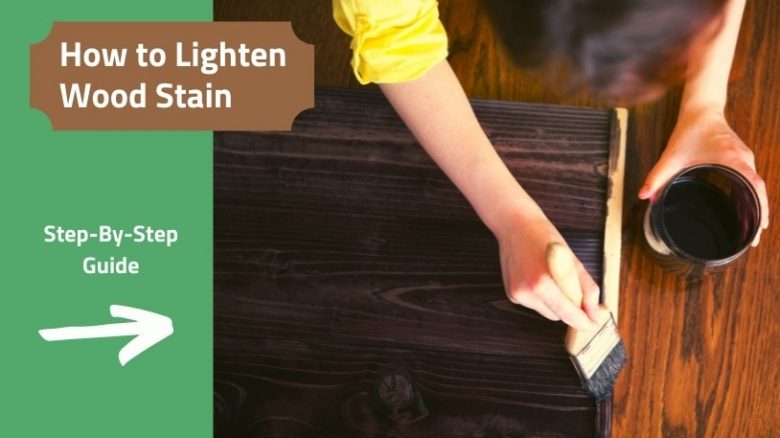There are several ways you can lighten stained wood, using chemical, mechanical, and surface coating methods. It’s a technique that has gained favor in recent years as people repurpose old furniture to suit today’s fashions and interior designs.
I grew up with a mother who loved buying antique furniture. It then fell to my father to take furniture that looked decidedly ordinary and turn it into something special, suitable for sale or use in our house. I learned many techniques from my Dad and still use them in my woodwork today.
In this article, we’re going to cover several techniques to lighten wood that has been stained, mentioning some staining tips and tricks along the way. Stay with me for the next few minutes, and I’ll give you all the information you need to breathe new life into your furniture.
Can you lighten the wood stain?
You can lighten wood stains by thinning the liquid so that less pigment is in suspension relative to the base liquid. As a result, the color will be lighter when applied. To lighten already stained wood, you will have to use bleach, sandpaper, or steel wool.
I like to thin the stain so that two or three coats are needed to sneak up on the depth of color I seek. Decant the amount of stain you think you’ll need into a clean, dry container and thin it with either mineral spirits for oil-based stains or water for latex or water-based stains. Stir well before application.
How to lighten dark stained wood
For this discussion, we’re assuming you have a piece of wooden furniture that someone previously finished in a dark stain, and you now wish to lighten. You can use three methods: bleaching, steel wool, or sanding. When using the first two methods, you’ll need to remove the varnish or polyurethane that protects the stain.
Things you’ll need to remove the topcoat:
- Paint and varnish stripper
- A paintbrush
- A scraper
- Steel wool
- Drop cloths
- Gloves
- Eye protection
Set yourself up in a well-ventilated area, being sure to put drop cloths around and under your piece of furniture to be sure drips and splashes don’t harm other parts of your home or workshop. Following the instructions on the stripper container, brush the stripper onto all areas of the furniture you wish to lighten. To avoid chemical burns, be sure to use personal protective equipment for your skin and eyes.
Leave the stripper to work for the time recommended by the manufacturer, then using the scraper at a 45-degree angle, scrape off the softened topcoat. Be careful not to let the corners of the scraper damage the surface of your furniture. For hard-to-reach nooks and crannies, use steel wool to remove the residue.
Once the topcoat is removed to your satisfaction, wash and scrub the surface with soapy water. Allow the furniture to dry before moving to the next step.
How to lighten wood stain using bleach
You have three choices of bleaching agents.
When diluted to between 3% and 8%, you’ll know sodium hypochlorite as household bleach. It’s effective on dye-based stains but ineffective on pigment-based stains.
Calcium hypochlorite is used as pool chlorine. It’s a more potent chemical than sodium hypochlorite for stain lightening. Again, being chlorine-based, it’s ineffective on pigment-based stains. Usually supplied in granular form, it’ll need to be mixed with water.
Unlike the two previous alkaline products, oxalic acid is an organic acid used for cleaning and bleaching. It comes in crystal form and is dissolved in warm water until the solution is saturated, meaning the water can absorb no more crystals.
You’ll see a fourth product in shops: a two-part kit consisting of sodium hydroxide & hydrogen peroxide. It’s marketed as a wood bleaching solution, and it removes color from natural wood very well. However, I’ve found it doesn’t work so well on stain.
Instructions:
- Follow safety precautions when using these chemicals, being sure to cover your skin, use gloves, and protect your eyes from splashes. Make sure you do this process in a well-ventilated area, and when using the oxalic acid, wear a mask when mixing and using the product; otherwise, you’ll breathe in the acid, which will affect your breathing. Also, do not use metal containers to hold these products. Glass or plastic only!
- Use a synthetic paintbrush to apply the bleaching agent to the surface, ensuring all surfaces are covered without letting the liquid pool in any one spot. Leave to work overnight and, if necessary, apply a second coat. Allow four hours for the last coat to dry before neutralizing.
- Neutralize the surface by wiping the surfaces down with a cotton rag soaked in water before wiping dry with another cloth. Repeat this process. Finally, allow the wood to dry naturally for a day or more.
- Having bleached the stain, you can now decide whether to apply a lighter stain or go with the look you’ve achieved from the bleaching process. Once you’ve reached the color you want, you can reapply a clear topcoat of varnish or polyurethane to protect the surface.
Important note on safety
You’ll read some articles that suggest neutralizing the surface with a mix of water and vinegar. Do not use vinegar with bleach. When you mix bleach with vinegar or acid, it can give off chlorine gas, which can be lethal.
How to lighten wood stain using steel wool
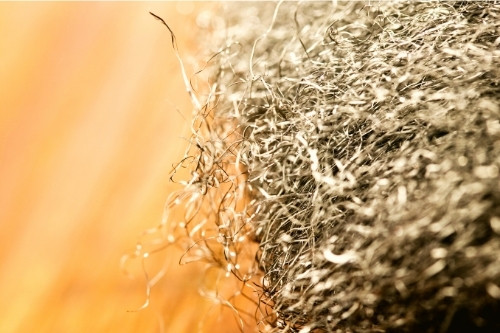
If you only wish to lighten the stain a little, steel wool might be the answer. It abrades away the stain on the surface of the wood, making it appear lighter. As with bleaching, you’ll need to have stripped off the clear top coat before using the steel wool.
Things you’ll need:
- Superfine grade steel wool (#0000, or 4/0)
- Water
- Mineral spirits
- Rubber gloves
- Eye protection
- Cotton cloth
Instructions:
- Dip a piece of steel wool into the water, wringing out any excess. Begin rubbing the steel wool over the surface of the wood in the direction of the grain. Maintain an even, light pressure. Do not rub across the grain, as you’ll introduce scratches that will be hard to remove.
- Every so often, refresh the steel wool in the water to remove accumulated wood dust and stains. Be sure to evenly cover the entire surface without focusing too much on one spot and without too much overlapping; otherwise, you’ll get a patchy finish.
- Once you’ve finished with the wire wool, put on your glasses and rubber gloves to clean the surface with mineral spirits, dampen a cloth with mineral spirits, and begin wiping along the grain of the wood. You’ll notice the cloth picking up color and the surface of the wood lightening slightly. Continue until the entire surface has been wiped down, changing the surface of the cloth regularly as it gets dirty.
- If the stain has reached the lighter shade desired, you can stop. If not, repeat the process, beginning with the steel wool and then wiping it down with mineral spirits. Once complete, wipe the whole surface down with a dry cloth and leave it to dry.
Now, you can apply a lighter stain if you wish before reapplying a clear topcoat of varnish or polyurethane.
How to lighten wood stain with sanding
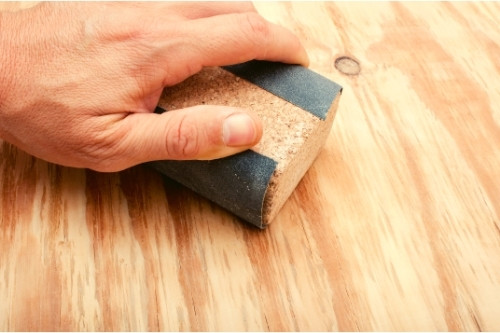
Sanding is the more aggressive approach but probably the quickest. You don’t need to strip off the top coat as the sanding will power through it all.
Things you’ll need:
- 80, 120, and 220 grit sandpaper
- A sanding block (or an electric palm sander)
- Mineral spirits
- Rubber gloves
- Eye protection
- Cotton cloth
Instructions:
- Start by using the 80-grit sandpaper to take off the worst of the topcoat and stain, then as the wood begins to lighten, work your way through 120-grit. If you want a really fine finish, you can use 220-grit, although it won’t soak up as much stain.
- Dampen a cloth with mineral spirits and begin wiping along the grain of the wood to remove all sanding dust and stain residue.
- Once complete, wipe the whole surface down with a dry cloth and leave the wood to dry. Now, you can apply a lighter stain to give you the finish you desire before applying a clear topcoat.
How to lighten dark stained wood floors
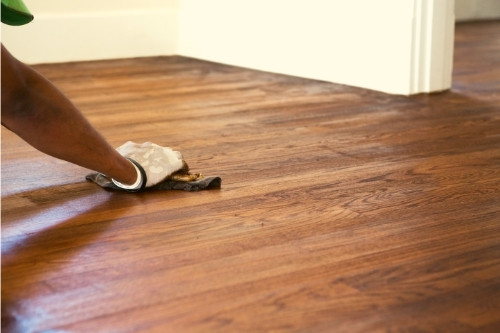
If you have a stained wooden floor that’s too dark for your liking, all of the solutions described in this article will work. However, floors are a larger expanse and require a bit of thought. For a large floor, the simplest way would be to hire a floor sander and edge sander and sand the floor back to remove the topcoat and stain. You can use a belt sander for a smaller area and do it by hand. Start by using 80-grit sandpaper before working your way to 100-grit, then finish with 120-grit. Clean, dry, and vacuum the floor before applying the stain of your choice and resealing it with a clear coat.
Read More: Do You Have to Seal Stained Wood?
If you wish to use the bleach method, you can, but I wouldn’t recommend it as bleach can soften the wood fibers, making the floor more easily damaged from foot traffic and furniture. However, here’s what to do if you’re adamant bleach is the right way for you.
While the varnish stripper will remove the top coat, you might also choose to use lacquer thinner or denatured alcohol, depending on which clear coat product was used. You can test a small area to see which softens the finish.
If you are using thinner or denatured alcohol, professionals use the trick of laying out rags or newspapers on the floor and soaking them in the liquid. Be sure you have adequate ventilation, use an appropriately rated mask, and extinguish all ignition sources! Once the finish is soft, use a scraper to remove it. With the topcoat removed, sand the floor with 120-grit sandpaper to lift the remaining stain.
Give the floor a good final vacuum and wash to remove all residue and allow it to dry. Now apply the bleach solution as described in the bleaching section, then neutralize the floor before allowing it to dry again. Now apply your chosen stain or surface finish.
Can you stain dark wood lighter?
Not often, but sometimes. Your success depends on a few variables. A lot depends on the darkness of the stained wood you wish to lighten, the degree of lightening you seek, and which stain you’ll be applying.
Stains can be either dye stains or pigmented stains. Dye stains are quite transparent and are designed to show as much of the wood grain as possible. Using a lighter dye stain over a dark stain will not lighten it and can, perversely, make it look darker.
Using a light-pigmented stain over a darker stain will block the darker colors to some degree. However, you’ll also lose a lot of definition in the wood grain. My advice would be to test a small, inconspicuous area to see the effect.
If in doubt, I’d be reaching for the sander and doing the job properly.
How to stain dark wood lighter
If you are using a pigmented stain, you’ve tested an inconspicuous area and like the effect, and you wish to proceed, here’s what to do. Follow the instructions at the start of this article, where I describe the removal process for varnish or polyurethane. Then, lightly sand the area using 120-grit sandpaper to smooth down the grain before vacuuming and cleaning the surface.
Once the wood is clean and dry, apply your pigmented stain to the manufacturer’s directions. Use the number of coats necessary to lighten the underlying stain and gain your desired effect. Once the stain is dry, apply your chosen clear topcoat.
DIY staining tips
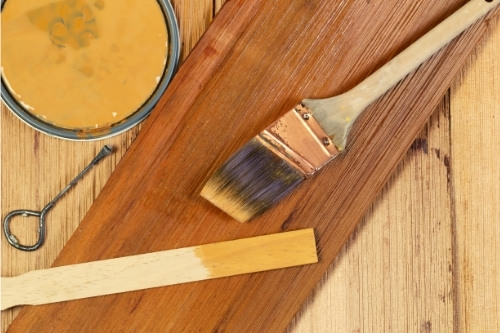
- Ensure the wood is adequately dry before applying the stain. If the wood is too wet, it won’t absorb the stain, and you’ll get patchy results.
- Stir the stain thoroughly to ensure all color is evenly dispersed; otherwise, results will be patchy.
- Avoid overlapping dry areas of stain with the wet stain you’re applying as it builds up, giving a banding effect where the overlap occurs.
- Use oil-based stains for exterior use and where you need deep timber absorption of the stain.
- Allow at least one hour between coats and 48 to 72 hours before top coating.
- Thin the stain if you want to lighten the color, using as a thinner whatever liquid you’d use for cleanup.
Related: How To Stain Wood [Beginner’s Guide]
FAQs
Can you use mineral spirit to lighten wood stains?
Yes, remove any clear topcoat before rubbing #0000 steel wool soaked in water with the wood grain to lift some stain, then wipe with a cloth soaked in mineral spirits. Repeat until you achieve the desired lightening effect.
Can you put a darker stain over a lighter stain?
Not always. Using a pigmented stain over a darker stain can cover the darker color depending on the degree of lightening you seek. However, it also obscures the wood grain.
Can you bleach stained wood?
Yes. Remove any clear finishing coats before applying your bleach solution. Allow the surface to dry before repeating the bleach application. Neutralize the surface with water and allow it to dry. Stain and apply a clear top coat to finish.
Can you stain mahogany wood lighter?
Yes, but first, you need to bleach the wood to remove a lot of the color. Remove the surface finish using a two-pack of wood bleach, such as this product. Once you have the look you want, neutralize the bleaching solution. Dry and sand the wood. Then, apply your lighter stain and finish with a clear coat.
Can you dilute wood stain?
Yes. Decant what you intend to use into a separate container and thin it with whatever fluid the manufacturer suggests for cleanup. Use water for water-based stains and mineral spirits for oil-based stains. Stir thoroughly. Don’t thin more than you can use in half an hour; otherwise, you’ll find the stain will begin to thicken as the thinning agent evaporates, making the stain darker.
Staining wood lighter conclusion
Lightening stained wood is not a difficult process, but it does require some patience and hard work. Please be sure to follow all the safety precautions mentioned, as you’re using harsh and flammable chemicals, some of which give off nasty fumes. Be sure to neutralize or wash the surfaces well between steps. By keeping the wood clean, your finished product will be something to be proud of. Good luck!

